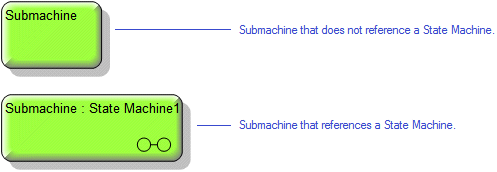Submachine state (dictionary item)

For automation interface information about a Submachine State, see
Submachine State.
For automation interface purposes, a Submachine State is a State that has its UML State Type set to Submachine.
A Submachine State specifies the insertion of the specification of a Submachine State Machine.
Create a Submachine State through a Modeler explorer pane or a State Diagram:
• In a Modeler pane, right-click a State Machine or Sequential State, and select > . Modeler prompts you to select or create a State Machine for the Submachine State.
• On a State Diagram tab, click the  Submachine State button, and then click the diagram background (within the frame) or within a Sequential State. Modeler prompts you to select or create a State Machine for the Submachine State.
Submachine State button, and then click the diagram background (within the frame) or within a Sequential State. Modeler prompts you to select or create a State Machine for the Submachine State.
 Submachine State button, and then click the diagram background (within the frame) or within a Sequential State. Modeler prompts you to select or create a State Machine for the Submachine State.
Submachine State button, and then click the diagram background (within the frame) or within a Sequential State. Modeler prompts you to select or create a State Machine for the Submachine State.• Drag the State Machine that is going to be used by the Submachine from a Modeler pane to the State Diagram.
• Right-click a Sequential State that owns one or more items, and then click Convert to Submachine State.
When used on a State Diagram, a Submachine State's notation is as follows.

The View Options on a State Diagram allow you to show or hide the Name. By default, the Name is not shown.
Submachine state view options - state diagram.
On a State Diagram, you can populate Submachine States: right-click the State Machine (frame) or Sequential State that owns the Submachine States, point to Populate, and then click Normal States. Note that all owned Submachine, Atomic, Concurrent and Sequential States are added to the diagram.
In the Dictionary pane, Submachine States are listed in the UML\States folder.
The following sections provide information about how a Submachine State is used in the model.
Properties
A Submachine State has only the standard properties.
Owned by
 Atomic State (through child State Diagram)
Atomic State (through child State Diagram)Owns
 Dependency - The Dependency is owned jointly by the Submachine and the other associated item. The access permissions you have to a Dependency are determined by the access permissions of the dependent item.
Dependency - The Dependency is owned jointly by the Submachine and the other associated item. The access permissions you have to a Dependency are determined by the access permissions of the dependent item. Transition - The Transition is owned jointly by the Submachine and the other associated item. The access permissions you have to a Transition are determined by the access permissions of the source item.
Transition - The Transition is owned jointly by the Submachine and the other associated item. The access permissions you have to a Transition are determined by the access permissions of the source item.Defined in these parts of the model
Shown on these diagrams
Can be linked to these dictionary items
In addition to the owning State Machine or Sequential State, a Submachine State can be linked to the following items.
 Stereotype - To make a Submachine State valid for a Stereotype, make State Machine a valid item type.
Stereotype - To make a Submachine State valid for a Stereotype, make State Machine a valid item type. on the Submachine State's icon indicates that the item is a
on the Submachine State's icon indicates that the item is a
 Sequential State
Sequential State State Machine
State Machine Comment
Comment Connection Point Reference
Connection Point Reference Constraint
Constraint State Model
State Model State Diagram
State Diagram Variant Diagram
Variant Diagram